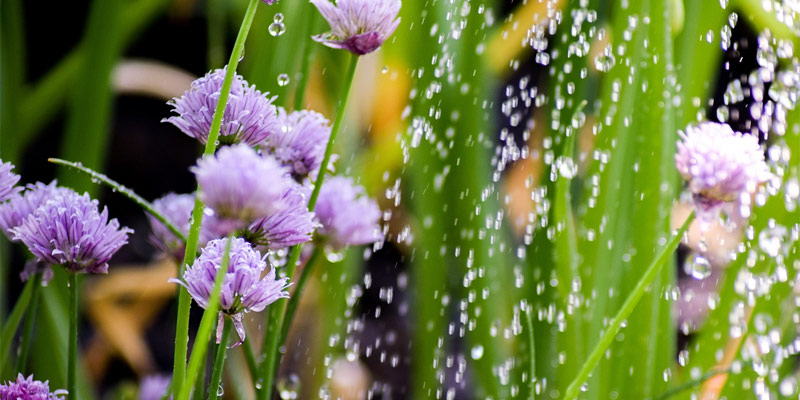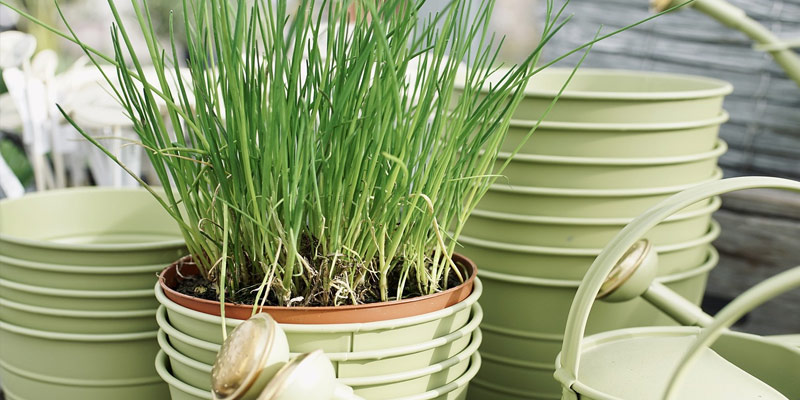Their delicate foliage and subtle onion flavor make chives a delightful addition to any herb garden or kitchen window sill. We prize these versatile perennials for their resilience and ease of cultivation, but like all plants, they require specific water conditions for optimal growth.
This comprehensive guide explores the water needs of chives, and delves into factors that influence their hydration requirements; moreover, it outlines best practices such as consistent watering to guarantee year-round health and vibrancy in your plants.
Understanding Chives and Their Water Needs
Members of the onion family (Alliaceae) include chives (Allium schoenoprasum), native to Europe, Asia, and North America. Known for their slender hollow leaves and globe-shaped clusters of pink to purple flowers, these herbaceous perennials thrive in a variety of growing conditions.
However, their health and vigor depend on maintaining proper soil moisture; hence they are adaptable plants that require this essential condition.
4 Factors Influencing Water Requirements
Several factors influence the water needs of chives:
1. Climate
Climate significantly determines the water requirements of chives. Chives in regions with hot, dry summers might need more frequent watering to avert soil moisture depletion and dehydration.
In contrast, chives in cooler and more temperate climates may demand less water; this is particularly true during periods characterized by increased humidity or rainfall.
2. Soil Type
The type of soil impacts water retention and drainage, subsequently influencing chives’ water needs. Thus, chives prefer soil with well-drained characteristics: a type that ensures good aeration to thwart waterlogging and root rot.
Sandy or loamy soils exhibit swifter drainage; consequently, they may demand more frequent watering. In contrast, clay soils maintain moisture for extended periods: thus necessitating less regular irrigation.
3. Growth Stage
The water requirements of chives are also influenced by their stage of growth. Newly planted seedlings and young chive plants might necessitate more frequent watering; this is crucial for root establishment and growth support.
Established root systems in mature chive plants may enhance drought tolerance; nevertheless, they still thrive on consistent moisture for the maintenance of healthy foliage and flower production.
4. Seasonal Variations
The temperature, humidity, and rainfall variations of seasons can impact chives’ water requirements; during the hot summer months – in response to enhanced evaporation and transpiration rates – chives may necessitate an increased intake of water.
In contrast, during the cooler spring and fall seasons, chives may necessitate reduced water intake particularly when rainfall proves sufficient for their requirements.
Optimal Watering Practices for Chives
Consider these watering practices to guarantee your chive plants receive sufficient moisture, without succumbing to waterlogging:
Watering Frequency
Deeply and thoroughly water the chive plants, permitting a slight dryness in the soil between each watering. Your aim should be to irrigate your chives once or twice per week, adjusting frequency according to weather conditions and moisture levels within the earth.
Typically, you’ll find that when there’s an inch (2.5 cm) of dryness on topsoil—it is time for rehydration.
Morning Watering
In the morning, ensure you water your chive plants to minimize evaporation-induced water loss; this strategy also guarantees sufficient drying time for foliage before evening. Prolonged moisture on the leaves overnight escalates potential risks of fungal diseases – notably powdery mildew and leaf spot.
Avoid Overwatering
Excessive moisture can induce waterlogged soil and root rot in chive plants. It is crucial to let surplus water drain unhindered from the base of containers or raised beds; additionally, emptying saucers prevents pooling around the roots, which is a detrimental condition for healthy growth.
Mulching
Apply a layer of organic mulch—straw or shredded leaves, for instance—around chive plants. This strategy assists in three essential functions; it retains soil moisture, suppresses weeds, and regulates soil temperature.
Furthermore, a significant benefit worth noting is that mulching mitigates water evaporation from the soil surface. This aids conservation efforts by minimizing moisture loss and decreasing the frequency of required watering.
Deep Root Watering
Directly water the base of chive plants or deposit it onto the soil and avoid overhead watering. This strategy aids in guaranteeing that water penetrates into the crucial root zone where it is most required. This method enhances drought tolerance and promotes overall plant health by encouraging deep-root growth.
4 Signs of Water Stress
You can identify when chive plants need watering by understanding the signs of water stress in them. These often present as:
1. Wilting: When chive plants lack sufficient moisture, they may wilt or droop; this signals their struggle to access water, which is a clear indication that immediate recovery requires immediate watering.
2. Yellowing Leaves: Chive leaves may turn yellow or brown due to water stress, with the discoloration often initiating at leaf tips or edges and advancing inward in case of continued moisture deficiency.
3. Stunted Growth: Chive plants in severe water stress may show stunted growth or reduced foliage production; they redirect energy and resources towards essential functions – primarily root development and survival.
4. Flower Drop: Chive plants, in an effort to conserve moisture and resources as a survival mechanism, may prematurely drop their flowers due to insufficient water. During drought or periods of water stress, the occurrence of flower drops is probable.
Adjusting Watering Practices
Consider adjusting your watering practices accordingly if you observe signs of water stress in your chive plants; these adjustments may mitigate the issue.
1. Increase Watering Frequency: Should chive plants display wilting or other signs of dehydration, escalate your watering frequency; this will guarantee consistent soil moisture levels.
2. Deep Watering: Ensure deep and thorough watering for chive plants to allow moisture penetration into the root zone, thereby reaching the entire system. By encouraging deep-root growth through this method, we enhance their resilience against drought conditions.
3. Mulch: Apply a thicker layer of mulch around chive plants; this will assist in retaining soil moisture and diminishing water evaporation from the soil surface. Furthermore, mulching regulates soil temperature, which is an effective method to suppress weeds and thereby foster a more favorable environment for chive growth.
Conclusion
Understanding the water needs of chive plants and implementing best watering practices are crucial for ensuring their health, vitality, robust growth, abundant foliage, and flavorful harvest. You can cultivate vibrant chives that thrive in your garden or kitchen by mastering proper watering techniques.
Whether you choose to grow them in containers; raise beds; or traditional garden beds – chives will reward you with both aesthetic beauty and delightful flavors when given optimal moisture balance along with meticulous care.


Leave a Reply